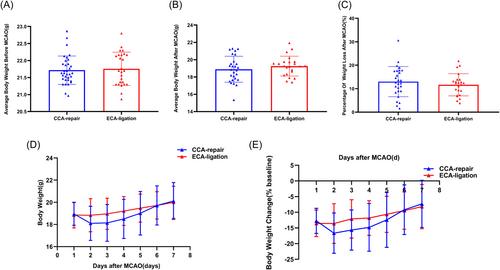CCA repair or ECA ligation—Which middle cerebral artery occlusion is better in the reperfusion mouse model?
Abstract
A reliable animal model is essential for ischemic stroke research. The implications of the external carotid artery (ECA) transection or common carotid artery (CCA) ligation have been described. Thus, a modified animal model, the CCA-repair model, has been established, and studies have shown that the CCA-repair model has potential advantages over the CCA-ligation model. However, whether the CCA-repair model is superior to the ECA-ligation model remains unclear. Sixty male C57BL/6 mice were randomly assigned to establish the CCA-repair (n = 34) or ECA-ligation (n = 26) models. Cerebral blood flow before middle cerebral artery occlusion (MCAO), immediately after MCAO and reperfusion were monitored and the operation duration, postoperative body weight, and food intake within 7 days, and the number of intraoperative and postoperative deaths within 7 days were recorded in the two models. Modified neurological severity scores and Bederson (0–5) scores were used to evaluate postoperative neurological function deficits on Days 1/3/5/7. 2,3,5-Triphenyltetrazolium chloride staining was used to quantify lesion volume on Day 7 after the operation. We found the establishment of the CCA-repair model required a longer total operation duration (p = 0.0175), especially the operation duration of reperfusion (p < 0.0001). However, there was no significant difference in body weight and food intake development, lesion volume and intragroup variability, neurological function deficits, mortality, and survival probability between the two groups. The CCA-repair model has no significant advantage over the ECA-ligation model. The ECA-ligation model is still a better choice for focal cerebral ischemia.


 求助内容:
求助内容: 应助结果提醒方式:
应助结果提醒方式:


